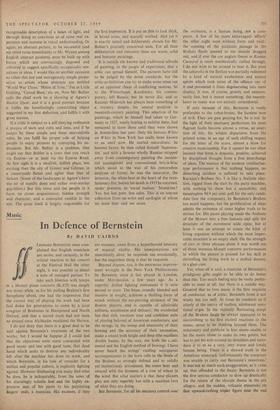Art
Via Euston
By SIMON HODGSON 1r may be that critics get tired of the same old truths. It is certain that, in inventing newer and newer descriptive words, newer and newer tags for schools and parts of schools, they forget the basic fact that there is very little to say about pictures, and that what there is to say is simple and unalterable. Let me try to be more explicit. I would define a good portrait as one which gives a good idea of the sitter's face and physique, and through this gives a convincing idea of that person's character. Mr. Robert Buhler, for instance, has nothing to be ashamed of, for I can go beyond this banal little definition and say that a landscape painter of the most specialised kind (say Mr. Jack Smith) is successful only if he sets down a convincingly recognisable description of a beam of light, and through doing so convinces us of some real ex- perience and increase in visual understanding. Or again, an abstract picture, to be successful (and my mind turns immediately to Mr. Wynter among English abstract painters), must be built up with forms which are convincingly disposed and coloured to suggest specifically recognisable sen- sations or ideas. I would like on another occasion to relate this last and outrageously simple propo- sition to artists whose abstracts are entitled 'World War Three,' Helen of Troy,' Tea at Little Gidding,"Carnal Blast,' etc. etc. Now Mr. Buhler calls the chief work he is showing at Agnew's Ruskin Spear, and it is a good portrait because it fulfils the humiliatingly constricting object suggested in my first definition, and fulfils it with great success.
If a critic is subject to a self-denying ordinance it propos of sects and cults and isms, and if he judges by these simple and these unavoidable rules, he can fulfil his proper role of helping people to enjoy pictures by conveying his en- thusiasm. But Mr. Buhler is a problem. One might say that Buhler is a town that you reach via Euston—or at least via the Euston Road. At first sight it is a smallish, dullish place, less exciting than the city of Ginner and Gilman, in a countryside flatter and uglier than that of Sickert. (Some of the landscapes at Agnew's have the air of rapidly done and rather over-similar gap-fillers.) But this town and the people in it have, on closer acquaintance, hidden strength and character, and• a concealed twinkle in the eye. The paint itself is largely responsible for the first impression. it is put on thin to look thick, in broad areas, and scarcely worked. And yet it is exactly suited and deliberately chosen for Mr. Buhler's precisely conceived ends. For all their deliberation and reticence these are warm, solid and humane paintings.
It is outside the known and traditional schools of painting, in the jungle of experiment, that a critic can spread himself. The pictures have still to be judged by the driest standards, but the critic-as-historian can try to make some sense out of an apparent chaos of conflicting motives. So to the Whitechapel. Kandinsky, his contem- porary, left Russia, but he never did; and so Kasirnir Malevich has always been something of a mystery despite his central position- in twentieth-century painting. This selection of his paintings, which he himself had taken to Ger- many in 1927, vainly hoping to exhibit them, had remained in store there until they were shown in Amsterdam last year. Only his famous White on White in New York has really been known to us until now. He started naturalistic; he became fauve; he then called himself 'Suprema- tist,' and with a fervour wholly Russian stripped away from contemporary painting the inessen- tial assumptions and conventional bric-a-brac which stood in the way of his remorseless analyses of forms; he was the innovator, the inventor, the white-heat at the heart of the revo- lutionary fire; before his death in 1935 he returned, under pressure, to 'social realism.' Mondrian? Yes, but less pure, less calm. This is an uneven collection from an artist and apologist of whom we must hear and see more.







































 Previous page
Previous page